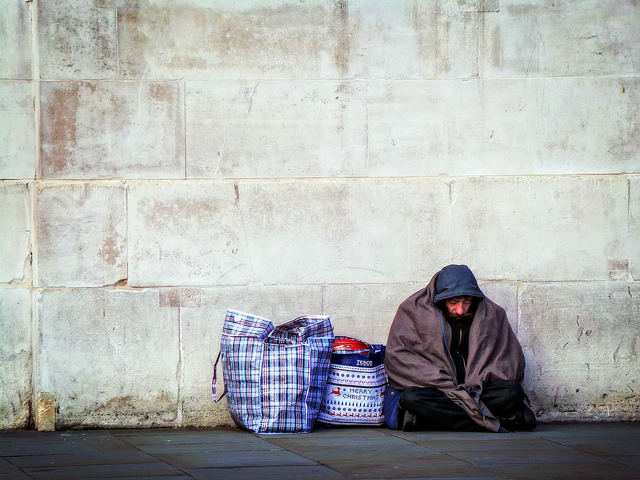Our nation’s biggest and brightest cities are known for having amazing skylines, industries and restaurants—and for many residents, their concrete sidewalks provide a path to high-paying jobs.
For others, however, those same sidewalks provide a cold and uncomfortable night’s sleep.
We are so quick to recognize the hustle and bustle, the rush-hour traffic, and the high-rent housing in America’s cities, but we tend to forget about those who don’t have any housing at all.
More than 578,000 Americans are homeless, and nearly 35 percent of this population struggles with addiction—a staggering number, especially when compared to the general populace (8.2 percent).
Homelessness and addiction are serious issues that appear to go hand in hand. Therefore, they must both be addressed with equal fervor.
Open Your Eyes to Your Surroundings
As a businesswoman, entrepreneur, and mother, my family and business are both heavily involved in homeless relief efforts in our community. Having a roof over our head, a warm dinner every night, a clean bill of health, and a place we call home are so easy to take for granted—and we are reminded of this every time we volunteer at a shelter.
Even my 7-year-old son has been deeply moved by his volunteering experience. At his most recent birthday party, he proudly announced that he would donate half of his presents to homeless children, hoping to brighten up their days with some toys. Seeing this simple act of kindness and generosity from a young child makes our philanthropic efforts all the more meaningful.
It is so important for everyone to be aware of their surroundings and lend a helping hand to those in need. Volunteering at a shelter is just one way to get involved.
To maximize our efforts, it helps to develop a deeper understanding of the perpetual cycle of homelessness and addiction, as well as its contributing factors.
The Addiction Cycle
Drug addiction triggers a system of conditioning in the brain that causes addicts to make procuring and using drugs their top priority. Families, friendships, and professional responsibilities all take a backseat while these individuals go to great lengths to satisfy their cravings.
This results in poor judgment that leads to unemployment, accidents, violence, and homelessness—and without extensive, long-term treatment, these cravings and choices only get worse over time.
Due to their lack of financial resources and stable living conditions, achieving and maintaining sobriety is an especially difficult battle for the homeless community. However, while high-priced rehab facilities may be out of the question, there are plenty of realistic steps concerned citizens can take to break this cycle.
3 Ways to Break the Cycle
Life is short and full of struggles—and, really, we’re all in it together. If we can be there for one another and work as a team to make the world a better place, our existence will have a whole new meaning.
Here are three things we can do to tackle addiction and homelessness in our communities:
1. Educate yourself. Rather than rely on a general knowledge of the topic, spend time learning about homelessness and its contributing factors. While substance abuse is a major component, there are other factors at work such as mental illness and abusive backgrounds.
Learn about the homeless culture of your surrounding area as well. The homeless population in Houston, for example, will differ from the homeless population in my hometown of San Diego. The more time we spend educating ourselves and our families, the more knowledgeable we will be regarding the specific issues our local homeless communities are facing.
2. Focus on the entire family. Homelessness and substance abuse don’t just impact adults. A recent study conducted by The National Center on Family Homelessness revealed that 2.5 million American children are homeless annually—and it is especially heartbreaking to realize that many of them are homeless because of choices their parents made. Often, substance abuse can be traced all the way back to an addict’s teenage years, so in our efforts to stop this cycle, it’s imperative that we focus much of our energy on helping at-risk youth avoid the pitfalls of addiction and homelessness.
Adolescence is such an impressionable age, and there are so many ways we can make the right impression on young people’s lives and encourage them to make positive choices. My son’s act of kindness on his birthday is evidence of what happens when kids are instilled with good values at a young age.
3. Reach out, and make a difference. Whether it’s donating toys to a local after-school program, serving food in a soup kitchen, or simply downloading an app, every person reading this article has the power to make positive changes in his or her community. All it takes is a little effort.
Boys & Girls Clubs of America, Big Brothers Big Sisters, The Salvation Army, United Way—there are countless organizations and programs across the country working toward this cause, and a simple donation of time, food, or clothing can have a major impact.
Your city might be known for skyscrapers and sports teams, but why can’t it also be known for great shelters, youth programs, and low rates of homelessness?
People like you can make all the difference, and if we band together, we can tackle the cycle of homelessness and substance abuse one step at a time.
Author: Zeynep Ilgaz
Editor: Emily Bartran
Photo: Garry Knight/Flickr







Read 2 comments and reply